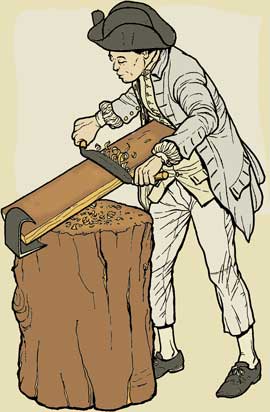Rémy Dupille.
Rémy Dupille was born about 1640 in the small parish of Ponchon near Beauvais, Picardie. His parents were Martin Dupille and Françoise LeMercier.
A mention in notarial records provides evidence he came to the French colony sometime before December 1666. Rémy was a charpentier according to these sources, including one in 1671 in Québec. Carpenters were an important component of any new settlement and were vigorously recruited.
Carpenter by Trade.

He would have fashioned his own tools, to fit his hand and his style. The axe was a part of every frontiersman's kit as it was used for everything from chopping wood for fuel, protection from man or beast, or building snares to trap game. The axes with their straight handles were worn in the belt so that they were always available. To fashion an axe head, a rectangular piece of iron was folded over a metal handle pattern. Then a steel wedge was inserted into the open end. This was hammered until it welded shut, then attached to the wood handle and sharpened.
Carpenters selected the trees to fell to build homes and furniture. The bark was stripped off but did not go to waste; oak bark was used in tanning hides. Logs were scored with a felling axe and then a broad axe was used to hew a straight line down the log to square it off.
Hammer head design was first perfected by the Romans and changed little since that time. The iron-headed tool was used on square iron nails which were clinched, or bent over the wood, insuring a solid join. When it came to pounding in wood pegs, wooden mallets were employed.
Settlers' homes in the 1600's may have been constructed of squared-off logs, or in later years a whitish grey stone quarried in the area or a combination of the two (half-timbered). Typically the 20 by 40 foot home was divided into two parts with wooden planks placing the cooking area at one end. A loft under the high peaked roof provided sleeping quarters for the children in their rather large families.
- Jetté, René, Dictionnaire généalogique des familles du Quebec des origines à 1730, Montreal: Les Presses de l'Universite de Montreal, 1983
- cite notaire Gilles Rageot
- Sloan, Eric. Museum of Early American Tools. Canada: Wilfred Funk, Inc.: 1964
- Early American Trades. Dover: 1980
- https://www.chroniclesofamerica.com/french/daily_life_in_new_france.htm Daily Life in New France (Date accessed 9/4/2015)
- Eccles, W.J. The Canadian Frontier 1534-1760 Revised Edition. Albuquerque: University of New Mexico Press: 1984
- https://fr.wikipedia.org/wiki/Saint-Augustin-de-Desmaures (2/1/16)
- https://www.thecanadianencyclopedia.ca/en/article/architectural-history-the-french-colonial-regime
